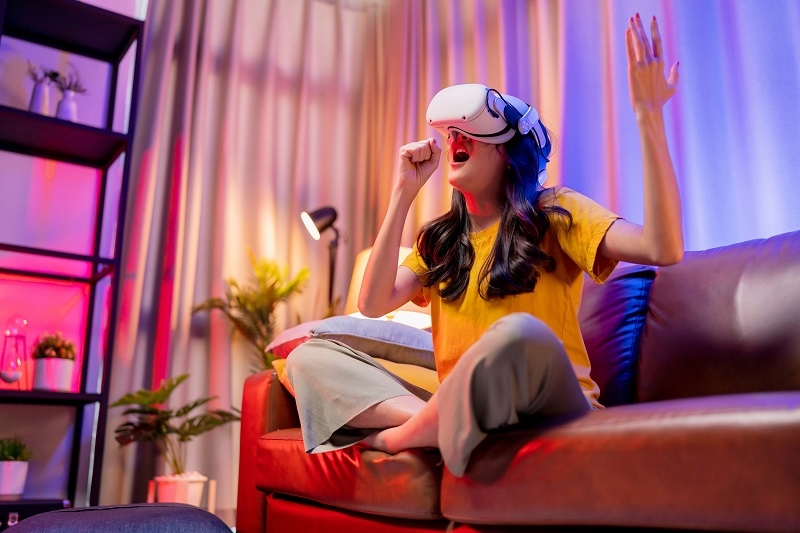The Future of Live Music Experiences With Virtual Concerts

The world of music has changed rapidly with the growth of technology. This has seen the rise of virtual concerts from just a trend to mainstream way to host shows and offer viewers an extremely immersive experience.
It is like you are sitting in your room and still feeling the energy of a packed crowd after seeing the artist. This is the reason many people believe that virtual concerts almost feel real.
In this blog, you will learn everything about virtual reality concerts to understand how it became a mainstream option for bands and artists to perform.
Top Pick: Exploring K-Pop's Global Influence on Pop Culture Trends
Virtual Reality Concerts Offer Immersive Experiences Like Never Before
The rise of virtual reality concerts has completely changed how people used to experience music. This is because it makes everyone feel they are in a real-life concert, while they are sitting in their room.
This technology allows you to explore the different areas of the stages and interact with others who are attending the show.
If you want to know the different things that you can do and experience in virtual concert, consider checking the following list:
Explore Digital Stages
Fans can move around virtual arenas without any restriction. This allows you to choose the area where you would like to stand and watch the show. You can even make adjustments to the angle and follow the singer to make your experience special. Virtual reality concerts offer a lot of flexibility to its viewers, unlike physical concerts, where almost everything feels fixed.
Interact with the Environment
Digital stages come with interactive features. Fans can explore lounges, click on visuals, or even trigger animations that happen during the performance. You can wander, discover, or just sit back and watch—it’s flexible.
Connect with Artists
Virtual reality music concerts often allow fans to talk or wave at artists digitally. They can ask questions, or just see behind-the-scenes moments. It creates a closer connection than traditional concerts usually do.
Better Audio and Visuals
High-definition video and audio make everything feel realistic. Multiple cameras let fans pick what they want to see. Every note, every movement, every expression feels present. You hear the drums clearly, you see the singer’s expressions, it’s a lot more engaging than standard video streams.
Virtual reality concerts are not just shows—they are experiences that feel personal. Every person sees it a little differently, and that makes it exciting.
Expanding Accessibility and Audience Reach With Virtual Concerts
Virtual concerts have removed many barriers to live music. No one needs to travel far or worry about tickets running out. Fans all over the world can join the show. Thus, it even helps artists to reach audiences that they never could before. Therefore, virtual concerts do not just feel convenient and inclusive, but also offers an extremely personalized feeling.
Global Audience Connection
Fans from different countries can watch the same show together. They can share their excitement in chat rooms or comment on the same digital space. It creates a sense of being together, even if they are thousands of miles apart.
Inclusive Experiences
People who couldn’t attend in-person events now can. Virtual concerts make music accessible for fans with mobility challenges or schedules that don’t allow travel. Everyone can feel part of the experience.
Personalized Viewing Options
Fans can pick camera angles, adjust sound, or even zoom in on the stage. Some may like to watch the drummer, some the singer. Everyone has their own way to enjoy it.
Creative Digital Performances
Artists can design performances that are impossible in physical venues. Animated visuals, interactive stages, and digital surprises give fans something new each time. No two shows need to feel the same.
Virtual concerts make live music something everyone can enjoy. Location doesn’t matter. Time zones don’t matter. And the energy of the crowd? That can be digitally replicated in surprisingly effective ways.

How Event Live Music is Helping in Building Communities?
Virtual concerts are more than watching—they are about taking part. Fans feel involved, like they belong. Event live music in digital form has focused on engagement, making audiences part of the story, not just observers.
Live Fan Interactions
Fans can talk to each other during shows. Chat rooms, virtual applause, and fan zones allow people to share excitement. Everyone feels like they are part of the same event.
Artist Engagement
Artists can respond to fans in real-time. They can answer questions, wave, or share behind-the-scenes moments. It makes fans feel seen and part of the performance.
Social Participation
Fans can meet others digitally to discuss about the songs and the performance. The virtual shows even allow the performers to build their digital stage which massively improves the experience of the crowd. Therefore, people get a social experience that almost feels similar to being in a crowd in real life.
Strengthened Community
These shared experiences build stronger connections. Fans feel part of a larger group, sharing emotions, excitement, and memorable moments together. It creates a sense of belonging.
Virtual concerts are not just about music—they are about people. About community. About shared experiences. And it works even when everyone is online.
Must Read: Top Pop Stars of 21st Century: Icons Shaping Today's Music
Technological Innovations are Improving Virtual Concerts
Virtual concerts are powered by technology. Virtual reality and augmented reality create immersive stages and visuals. Streaming is high-quality so fans hear every note, see every movement. The audience can explore the stage, interact, or just enjoy.
Fans can follow the artist, choose views, or even enter digital areas. The technology allows each concert to be unique. It brings the energy of live music directly into fans’ homes, and it keeps getting better with each new innovation.
How Virtual Concerts Help Sustainability and Inclusivity?
Virtual concerts are also better for the planet because people need to travel less which reduces the environmental impact. However, they are still inclusive because fans who cannot travel for physical shows can also enjoy live performances from of their favourite artists or bands. Apart from this, it also helps the artist to reach wider audiences and create experiences that everyone can enjoy. It is sustainable, inclusive, and keeps music alive for all fans.
Conclusion
Virtual concerts are changing the live music experience. With virtual reality concerts and interactive event live music, fans can enjoy performances from anywhere. They can feel part of the crowd, interact with artists, and join a community of music lovers. The future of live music is digital, interactive, and open to everyone.
This content was created by AI

